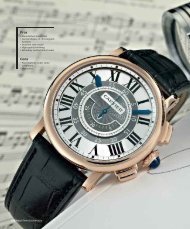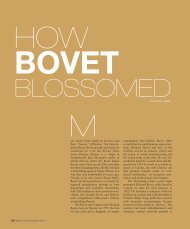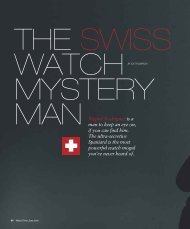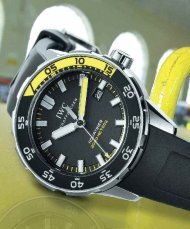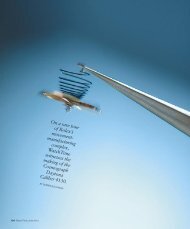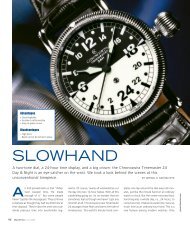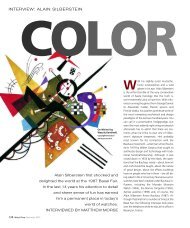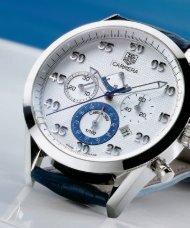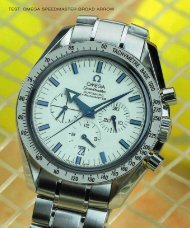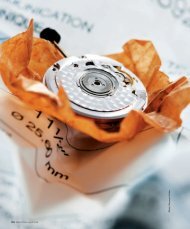wt_2004_03: test: audemars piguet jules audemars 3120 classic
wt_2004_03: test: audemars piguet jules audemars 3120 classic
wt_2004_03: test: audemars piguet jules audemars 3120 classic
Create successful ePaper yourself
Turn your PDF publications into a flip-book with our unique Google optimized e-Paper software.
TEST: AUDEMARS PIGUET JULES AUDEMARS <strong>3120</strong> CLASSIC<br />
ists from 15 nations work there under optimal<br />
conditions, and we can expect them to give<br />
the world additional masterpieces of the<br />
watchmaker's craft in the coming years.<br />
Most manufacturers have one or more base<br />
calibers, but seldom does a brand have much<br />
experience in the construction of complicated<br />
mechanisms. This wasn't the situation at Audemars<br />
Piguet; the company had plenty of<br />
complications, but the firm lacked a base caliber<br />
of its own that could be created in large<br />
numbers. For many years, AP had relied on<br />
Jaeger-LeCoultre's (JLC) Caliber JLC 889/2 for<br />
many of its models. But with the takeover by<br />
Richemont and the sale of its shares in JLC,<br />
AP's access to that coveted caliber gradually<br />
came to an end. AP seized the initiative, and<br />
introduced the hand-wound Caliber 3090 in<br />
1999. Caliber <strong>3120</strong> followed four years later. It<br />
combines automatic winding, a sweep seconds-hand,<br />
and a numerical window-type<br />
The caseback<br />
is securely held<br />
in place with<br />
five screws.<br />
The 22-karat gold rotor is engraved<br />
with the coats-of-arms of<br />
the Audemars and Piguet families.<br />
date display. Both of these calibers now serve<br />
as the new motors in simple watches from the<br />
house of Audemars Piguet.<br />
The new Caliber <strong>3120</strong> unmistakably reveals<br />
the manufacture's signatures: a harmoniously<br />
arranged series of bridges, with assembly bespeaking<br />
the utmost in skilled craftsmanship<br />
and elaborate decorations on the individual<br />
components. The rotor is truly a wonderful<br />
sight: Crafted from 22-karat gold, it's beautifully<br />
engraved with the coats-of-arms of the<br />
Audemars and Piguet families. A connoisseur's<br />
discriminating gaze feasts on a picture of elegantly<br />
well-balanced proportions, further enhanced<br />
by the crosswise orientation of the balance-bridge.<br />
The legendary Calibers 2120 and<br />
2121 form the technical basis. The automatic<br />
Caliber 2120 was first built in 1968. Slightly<br />
modified and renamed Caliber 2121, it attracted<br />
considerable attention in 1972 when it<br />
was encased within the Royal Oak, to which it<br />
offered a date display and a sweep secondshand.<br />
Ever since, it has remained a reliable<br />
power source for several models in the AP collection.<br />
The best features of these ticking timekeepers<br />
were integrated into the new Caliber <strong>3120</strong>.<br />
Some of its characteristics are mentioned in<br />
the following list. (Information in parentheses<br />
refers to the corresponding details in the older<br />
Caliber 2120.) Here are the specs: The ballborne<br />
rotor winds the mainspring in both its<br />
DATA PAGE<br />
Jules Audemars <strong>3120</strong> Classic<br />
Manufacturer: SA de la Manufacture<br />
d'Horlogerie Audemars Piguet & Cie,<br />
CH-1248 Le Brassus<br />
Model: Jules Audemars <strong>3120</strong> Classic<br />
Reference number: 15120BC.0.A002CR.01<br />
Case number: F 0217<br />
Movement number: 589981<br />
Functions: Hours, minutes, sweep<br />
seconds-hand, and date.<br />
Movement: Audemars Piguet Caliber <strong>3120</strong>;<br />
diameter = 26.6 mm (12.5 lignes); interior<br />
diameter of the movement-holder<br />
ring = 26 mm; height = 4.25 mm; 40 jewels;<br />
21,600 beats per hour A/h (3 hertz); Swiss lever<br />
escapement; Nivarox-I flat balance-spring;<br />
Gyromax balance; ball-borne, 22-karat gold<br />
rotor winds the Nivaflex 1 mainspring in both<br />
its directions of rotation; one barrel; 60-hour<br />
(± 5%) power reserve; Kif-Elastor shock<br />
absorption for the balance; stop-seconds<br />
function; 278 individual components<br />
Case: Massive, tripartite gold case; sapphire<br />
crystal in back; five screws hold back in place;<br />
crown is not screw-down; sapphire crystal above<br />
dial; water-resistant to 20 meters<br />
Wristband and claps: Leather strap with<br />
pronged buckle made of 18 karat gold<br />
Rate <strong>test</strong> and amplitude (when tully wound;<br />
deviations in seconds per 24 hours<br />
Dial up: +6 261°<br />
Dial down: +9 302°<br />
Crown left: +1 255°<br />
Crown up: -1 254°<br />
Crown down: +8 261°<br />
Grea<strong>test</strong> difference of rate: 10 50°<br />
Average deviation: +5 275°<br />
Dimensions: diameter = 38.7 mm,<br />
height = 9.5 mm<br />
Price: $14,800 in white gold with leather strap<br />
and pronged buckle.<br />
66 WatchTime June <strong>2004</strong>



